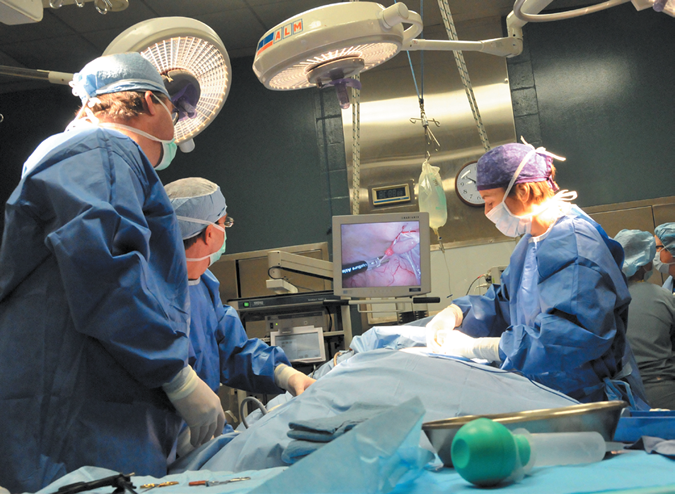Imagine if the time came that your dog needed an operation, and her recovery took a few hours instead of a few days in the hospital. It would result in her going through a lot less pain and could also mean less cost, since a stay in a veterinary hospital can easily run hundreds of dollars a day.
That time is here, or at least on the very near horizon, thanks to the advent of minimally invasive surgery in veterinary medicine.
Minimally invasive versus conventional surgery
How does minimally invasive surgery differ from current standard techniques? In conventional surgery involving, say, the abdominal cavity or the chest cavity, the incision has to be large enough to allow the surgeon to pass his hands through it. A larger incision increases the risk of discomfort during the first week after surgery.
Minimally invasive surgery, on the other hand, makes use of two to four tiny incisions, each no more than about a half inch in length. Small tubes, termed ports, are then positioned in the incisions to allow surgical instruments to be passed into the chest or abdomen. Through one of the ports the surgeon inserts a scope that projects images from inside the dog’s body onto a monitor.
That’s how the doctor sees what’s going on. The surgeon looks at the surgical site not directly but digitally — on the monitor, which is positioned adjacent to the operating room table. Thus, performing the operation is “like playing a complicated piano piece without looking straight at the keys but instead seeing them on a screen,” says John Berg, DVM, a Tufts veterinary surgeon and editor-in-chief of Your Dog.
Minimally invasive surgery performed in the abdomen is termed laparoscopic surgery. In the chest, it is called thoracoscopic surgery.
When will minimally invasive surgery hit the veterinary mainstream?
While minimally invasive surgery has been adopted in a number of large veterinary hospitals and universities, it is not yet available in most general practices. “Veterinarians are still in the process of perfecting the technique,” Dr. Berg says. The cost of the equipment for minimally invasive surgeries is also a barrier. Not only is it expensive to purchase; it’s also expensive to maintain. More surgeons have to learn how to use it and employ it in their practices on a regular basis to justify the cost.
But it’s all moving at a fast pace. Should your dog need an operation, chances are that it’s going to be performed conventionally; any future dogs in your life, however, are more likely to benefit from minimally invasive surgery. “The shift is going on right now,” Dr. Berg says.
Minimally Invasive Surgeries Your Dog Is Most Likely to Have
Down the road, it is possible that many kinds of minimally invasive surgeries will be performed routinely by veterinary surgeons, even rare ones like removing a lobe from a lung or a tumor from the adrenal gland. Currently, however, there are four surgical procedures that are routinely performed with minimally invasive techniques in large referral hospitals. Each allows the veterinarian to perform the surgery with much smaller incisions than would be necessary with conventional surgery. These include:
Liver biopsy. Blood tests and imaging can easily tell if something is wrong with a dog’s liver, but they often don’t tell what’s wrong. A biopsy is necessary for that. Minimally invasive surgery using a laparoscope takes all of 15 minutes to a half hour. The dog can go home the same day, and pain is minimal.
Spay. Performing a spay conventionally is generally not a big deal as far as operations go. “The incision for a conventional spay is pretty small to begin with,” Dr. Berg says. Even so, a laparoscopic spay does result in smaller incisions, and greatly simplifies the surgery in large, overweight dogs.
Pericardiectomy. Sometimes the sac around a dog’s (or person’s) heart — the pericardium — becomes filled with fluid that compromises the heart’s functioning. The sac is something that can easily be lived without, and it can be removed with minimally invasive surgery. It falls under the heading of thoracoscopic surgery since the incisions are made in the chest rather than the abdomen.
Prophylactic gastropexy. This surgery is done to prevent gastric dilatation and volvulus, known in the vernacular as bloat. It’s a sudden twisting of the stomach that is common and life-threatening in large and giant breed dogs. During the preventive surgery, the stomach is permanently sutured to the inside of the abdominal wall, preventing the condition.





